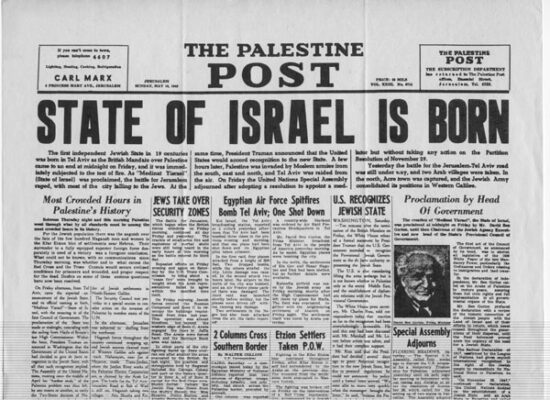
Britain was appointed by the League of Nations to oversee Palestine from 1920.
Here we have an important document with thousands of numbered correspondence between the British Foreign Office and Palestine, during the period when the state of Israel was becoming a physical entity.
From the introduction itself we are given an insight to the topics covered by the correspondences which throw a light on the real politic playing out as Israel was born, specifically from 1940 until 1946 and the withdrawal of British troops.
The document shows a distinction between the ideologies of the Arabs, the resident Palestine Jews, and the British political and military high command trying to balance the opposing views, and high emotion, as the game hotted up in the creation of the State of Israel. There is also insight into the difference between the Jews and the Zionist movement, a subject almost forgotten by the mainstream, leading to the current position that both Jews and Zionist’s today are falsely seen as one entity, a position which places global minds from the get go, on a path of a serious untruth from which the only outcome can be more frustration on all sides leading to actions carried out in ignorance of the facts.
The Middle East today is in turmoil, yet still the same untruths are peddled like sweets to children allowing the mainstream media and TV to fudge the words of the narrative. The simple fact is Zionism is not Judaism, but those controlling Israel from the get go most certainly are Zionist’s, and the methods which cause concern today, are pretty much the MO for those who believe they are the emissaries of the entity that demands statute control of the entire world.
The following is a comprehensive insight from the introduction alone, into the politics, the players and events of the day as the Balfour Declaration became manifest in the land called Palestine.
Snippets from the introduction of the document :
For the 1940-1946 records of Palestine and Transjordan, over 90 percent deal with Palestine. This is due to the problems that developed over the continued increase of the Jewish population through immigration. Palestine had a fairly modest and stable Jewish population in the nineteenth century. This started to change with the Zionist movement, which began sending young pioneers to prepare the way for a Jewish homeland. Zionist hopes were elevated to British government policy on November 2, 1917, with the Balfour Declaration, which stated that the British government was in favour of the establishment in Palestine of a national home for the Jewish people and will use their best endeavours to facilitate the achievements of that object, it being clearly understood that nothing shall be done which may prejudice the civil and religious rights of existing non-Jewish communities in Palestine.” For whatever reasons Great Britain adopted this position, it would soon be forced to try to implement the declara- tion. A month later British armed forces took Jerusalem and the mandate for Palestine and Transjordan was assigned to Great Britain in 1920.
The portion of the Balfour Declaration quoted above sets the conflict between Arabs and Jews. Great Britain would have to face the question of how to protect Arab Palestinian rights and at the same time establish a Jewish national home. The Zionists envisioned their national home as a nation state based on Jewish religion, culture, and language. The Palestinian Arabs had been on the land for generations and had their own religion, culture, and language. They had just been freed from the Ottoman Turks control, and Arabs had fought along with the British to defeat the Turks. Why should they now share or give up their land and political rights to a group of foreigners?
The White Paper was immediately rejected by Jews throughout the world and by the Palestinian Arabs, and the violence continued. However, the Zionists joined with Great Britain in September 1939 supporting the fight against Hitler’s Germany. This included Jewish restraint from the use of violence in Palestine during the war’s duration. Only Jewish extremists from the Stem Group and the Irgun broke the informal truce by committing terrorist attacks.
Despite over fifteen years of Foreign Office opposition to the creation of a Jewish state in Palestine, the pullout was a painful embarrassment in both a domestic and international sense for Great Britain. As an expression of the ending of Britain’s traditional place on the world stage and for the new era in the history of the Middle East that began that May 14, the British abdication of the Palestine mandate is of signal importance.
Palestine and Transjordan, 1940-1946@0
Further Study
What Is The Crown Temple?
How To Undo Secret Society, Political And Military Oaths Operating Fear Authority
Walpole’s Whigs, Privatising The Crown, Takeover Of The East India Company And The Church Of England
The Laws of Nation Are Not The Laws of State
The Corruption Remedy Process, Edward William Ellis
History Of Freemasonry, Albert Gallatin Mackey, Vol II, The Prussian Knight, 21st Degree
Freemasonry Is Deception, The Blue And Red Cross
1933 Bankruptcy Declarations And The Debt Slave, What You Need To Know
Winston Churchill : Zionism Verses Bolshevism 1920
What Will Britain Be Under Charles III?
What Is Happening To My Town And Who Is Responsible?
In Profile : Barnfield Construction Limited
Subverting British Politics, Vincent Tchenguiz The Gambler In Politics
History
Books